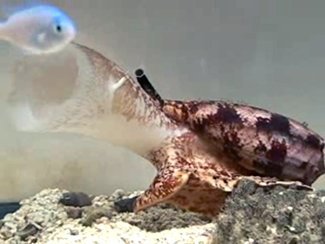Predatory snail strikes with unusual insulin weapon

A SPECIES OF venomous cone snail uses the hormone insulin in a totally new way – to slow down schools of fish and snatch them for lunch.
The Conus geographus snail – found across the Indo-Pacific region – uses a cocktail of bioactive molecules known as the ‘nirvana cabal’ to capture small fish. The venom is released into the water where it stuns and slows down small fish, which are then easily caught using a specialised bag-like structure known as a false mouth.
While cone snails are well known for unusual predation tactics, the deliberate use of insulin as a venom is unheard of, says scientists who report the discovery today in the journal Proceedings of the National Academy of Sciences.
Dangerous potency of insulin venom
“It is well established that high doses of insulin are potentially very dangerous and we pondered whether cone snails could be exploiting this and using insulin as a weapon,” says study co-author Dr Samuel Robinson at Monash University in Melbourne.
The hormone – which regulates our blood sugar level – is thought to make the fish sluggish, something like the lethargy experienced by diabetic people experiencing hypoglycaemic shock.
“Essentially the snail is flooding the fish’s system with an insulin molecule very similar to its own, causing a massive drop in blood glucose and sending the fish into a coma – exactly what would happen to a human if they were to overdose on insulin,” he says.
In invertebrates, such as the cone snail, insulin is involved in myriad tasks, from neuronal signalling and memory, to reproduction, growth and metabolism.
The variety of insulin used by the cone snails was also a surprise, as it is the smallest known insulin molecule yet discovered, and may offer insights into the structure and function of insulins that are useful to humans.
Better medical insulins for diabetics
“The cone snail venom insulin probably only has one function or goal, and that is to incapacitate prey as efficiently and as rapidly as possible. The venom’s insulin is probably small because it doesn’t require any extra bells and whistles, it is just finely-tuned to hit the fish receptor – to hit it hard and to hit it fast,” Samuel says.
“The insulins in cone snail venoms appear tailored for high potency and rapid activity. Millions of diabetics around the world use insulin as a drug, and understanding these specialised venom insulins could lead to the development of new, improved and more highly tuned insulins,” Samuel adds.
The discovery was made by an international team led by Dr Helena Safavi-Hemami and Dr Baldomero Olivera at the University of Utah in the USA.




